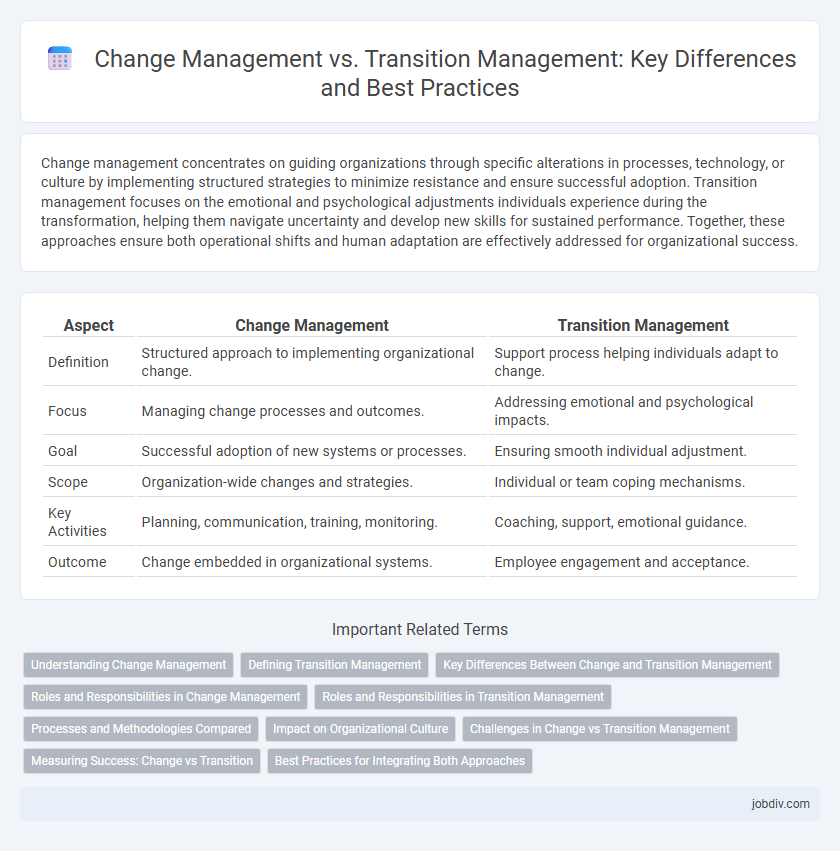Change management concentrates on guiding organizations through specific alterations in processes, technology, or culture by implementing structured strategies to minimize resistance and ensure successful adoption. Transition management focuses on the emotional and psychological adjustments individuals experience during the transformation, helping them navigate uncertainty and develop new skills for sustained performance. Together, these approaches ensure both operational shifts and human adaptation are effectively addressed for organizational success.
Table of Comparison
| Aspect | Change Management | Transition Management |
|---|---|---|
| Definition | Structured approach to implementing organizational change. | Support process helping individuals adapt to change. |
| Focus | Managing change processes and outcomes. | Addressing emotional and psychological impacts. |
| Goal | Successful adoption of new systems or processes. | Ensuring smooth individual adjustment. |
| Scope | Organization-wide changes and strategies. | Individual or team coping mechanisms. |
| Key Activities | Planning, communication, training, monitoring. | Coaching, support, emotional guidance. |
| Outcome | Change embedded in organizational systems. | Employee engagement and acceptance. |
Understanding Change Management
Change Management involves structured approaches to preparing, supporting, and helping individuals and organizations adapt to organizational change. It focuses on managing the human side of change by addressing employee resistance, communication strategies, and training to ensure successful adoption. Effective Change Management increases the likelihood of achieving desired transformation outcomes and minimizes disruption within the organization.
Defining Transition Management
Transition Management focuses on guiding individuals and organizations through the psychological and emotional shifts that occur during change, ensuring smooth adaptation and sustained performance. It emphasizes managing the human side of change by addressing employee mindsets, behaviors, and engagement throughout the transition period. Effective Transition Management reduces resistance and accelerates acceptance by supporting communication, training, and leadership alignment.
Key Differences Between Change and Transition Management
Change management focuses on implementing specific organizational changes, targeting structural, technological, or procedural shifts to achieve desired business outcomes. Transition management prioritizes the psychological and emotional adaptation of employees during the period of change, emphasizing support systems and communication to ease adjustment. The key difference lies in change management handling the "what" and "how" of change, while transition management addresses the "people side" and timing of adaptation processes.
Roles and Responsibilities in Change Management
Change Management roles primarily include Change Managers who design and implement change strategies, ensuring alignment with organizational goals. Key responsibilities involve stakeholder engagement, communication planning, and resistance management to facilitate smooth adoption of new processes or technologies. Change Agents support execution by addressing employee concerns and reinforcing desired behaviors throughout the transition phase.
Roles and Responsibilities in Transition Management
Transition Management focuses on guiding individuals and teams through the psychological and emotional adjustments required during organizational change. Roles include Transition Managers who facilitate communication, provide support resources, and monitor employee adaptation to new processes or structures. These responsibilities emphasize maintaining morale and productivity while ensuring a smooth shift from current to future states.
Processes and Methodologies Compared
Change Management centers on structured processes that address organizational shifts through clear methodologies such as ADKAR and Kotter's 8-Step Model, emphasizing communication, stakeholder engagement, and resistance management. Transition Management focuses on psychological and emotional processes facilitating individual and group adaptation, using methodologies like Bridges' Transition Model, which highlights endings, neutral zones, and new beginnings to support employee resilience and acceptance. Both approaches integrate complementary processes, with Change Management targeting external organizational changes and Transition Management addressing internal human adjustments for sustainable transformation.
Impact on Organizational Culture
Change Management concentrates on implementing specific changes within an organization, shaping processes and structures that directly influence organizational culture by promoting adaptability and resilience. Transition Management focuses on the human side of change, guiding employees through psychological and emotional adjustments that deeply affect cultural norms, values, and behaviors. Both approaches significantly impact organizational culture, where Change Management addresses systemic shifts and Transition Management fosters cultural alignment and employee engagement.
Challenges in Change vs Transition Management
Change management often faces challenges such as resistance from employees, unclear communication, and inadequate stakeholder engagement, which can hinder the successful implementation of new processes or systems. Transition management challenges primarily revolve around managing the human side of change, including emotional uncertainty, loss of institutional knowledge, and the need for continuous support to sustain performance during the shift. Both approaches require tailored strategies to address disruptions in organizational culture and maintain productivity throughout the period of transformation.
Measuring Success: Change vs Transition
Measuring success in Change Management involves tracking key performance indicators (KPIs) such as adoption rates, employee engagement scores, and the achievement of business objectives related to the change initiative. Transition Management success is evaluated by assessing how effectively individuals and teams move through the psychological and emotional stages of change, often using feedback surveys, readiness assessments, and retention rates. Combining quantitative metrics for Change Management and qualitative insights for Transition Management provides a comprehensive view of overall organizational adaptation and resilience.
Best Practices for Integrating Both Approaches
Effective integration of Change Management and Transition Management requires aligning organizational objectives with employee adaptability to minimize resistance and maximize engagement. Best practices include establishing clear communication channels, involving stakeholders early, and implementing continuous feedback loops to monitor progress and address challenges promptly. Leveraging tools such as stakeholder analysis, training programs, and change impact assessments enhances the seamless adoption of new processes while supporting individuals through the psychological and operational shifts inherent in transitions.
Change Management vs Transition Management Infographic

 jobdiv.com
jobdiv.com